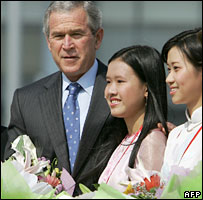Fears Over Asia-Pacific Free Trade Zone
 by Marwaan Macan-Markar
by Marwaan Macan-MarkarSpecial to Global Wire
Plans to create the world's largest free trade area at a summit of the Asia-Pacific Economic Cooperation (APEC) in Vietnam, this weekend, are being viewed with suspicion by activists.
''APEC should think carefully about creating a regional free trade zone,'' says Matthew Coghlan, regional trade policy officer for Oxfam, an international development organisation. ‘'APEC is made up of both developed and developing countries.''
Part of Oxfam's worry, he explained in a telephone interview from Phnom Penh, is the push by the United States government to achieve this goal by using Washington's current free trade agreement (FTA) model. ‘'If APEC is going to have continuing discussions for the creation of a free trade area in the Asia-Pacific region, then we don't want the U.S. FTA template being used as the basis for the creation of such a trade area,'' said Coghlan.
The U.S. government's record of adding new conditions to prevailing World Trade Organisation (WTO) agreements -- called ‘WTO-plus provisions' -- is behind such objections. ‘'A free trade agreement based on the U.S. model, with deep and rapid liberalisation, and WTO-plus provisions and commitments, will pose problems for them (developing countries) as they seek to develop,'' adds Coghlan. ‘'U.S. FTAs undermine the potential for poor countries to use trade to lift their populations out of poverty.''
Three areas where APEC developing countries, like all others, will be hit by the WTO-plus provisions include agriculture issues, intellectual property and investment. Peru and Thailand, two of APEC's 21 economies, could expect trouble in their agriculture sector, says Oxfam, since such deals ‘'fail to take into account the fact that the U.S. subsidises farm production with billions of dollars in taxpayer support.'' That means the ‘'small farmers in Thailand and Peru might face massive dumping of subsidised farm products on their market.''
The Pacific Rim countries that make up APEC account for close to 60 percent of the world's economy and about 50 percent of global trade. The grouping includes Australia, Brunei, Canada, Chile, China, Hong Kong, Indonesia, Japan, South Korea, Malaysia, Mexico, New Zealand, Papua New Guinea, Peru, the Philippines, Russia, Singapore, Taiwan, Thailand, the U.S. and Vietnam.
But how much the U.S. President, George W. Bush, may achieve at the summit in Hanoi, which starts with a formal dinner on Nov. 17 and runs through Nov. 19, has become an issue in the wake of two political developments in Washington. His Republican party's defeat by the Democrats in this month's elections to the Congress could translate into a possible slowing down of the U.S. free trade agenda, given concerns by Bush opponents over trade deals they say are hurting local workers.
‘'To what extent can he push ahead with his free trade agenda now, because he lost the elections and the attitude among the Democrats in the Congress towards free trade is well known?'' asks Goh Chien Yen of Penang-based Third World Network (TWN), a think tank lobbying for the rights of people in developing countries.
Also significant was the failure of the White House to win support Tuesday for a bill in the House of Representatives to grant APEC host Vietnam ‘'permanent normal trade relations'' (PNTR) status. It happened just as Vietnam, which fought the U.S. during Washington's Indo-China war against communism, was celebrating its latest milestone in the drive towards a free and open economy. On Nov. 7 the South-east Asian nation gained approval to become the 150th member of the WTO.
The APEC summit comes at a time when questions are being raised about the fate of global free trade and the WTO following the collapse of the Doha Round of talks for a new set of rules for international trade. This round began with a ministerial meeting in Doha, the capital of Qatar, in November 2001, aiming to make global trade more sensitive to the concerns of the world's poor, often the victims of free trade.
APEC has been a staunch ally of the WTO. At its November 2005 summit in South Korea, a ministerial declaration reaffirmed ‘'utmost importance'' to ‘'the successful conclusion of the (Doha Round) of negotiations by the end of 2006''.
Yet, the turn of events since then has triggered a call by anti-WTO voices, to APEC's developing countries, to push the agenda of the G-33 countries -- which represents a group of 33 developing nations from Africa, Asia and Latin America. This group, led by India, wants to restrict access to their agricultural markets. APEC's G-33 members include China, Indonesia, South Korea, Peru and the Philippines.
‘'It offers some measures of protection for small-scale farmers in developing countries,'' Shalmali Guttal, senior researcher at Focus on the Global South, a Bangkok-based regional think tank, told IPS. ‘'It is a proposal to allow Southern governments to designate which of their agriculture products can be protected from imports.''
These measures are meant to strengthen rural development, food security, local livelihood and development of local communities against the adverse impact of unrestricted agricultural imports. ‘'If you don't have a strong local economy for ordinary people, with good secure job, then no amount of trade liberalisation is going to result in sustainable development,'' adds Guttal.
Yet, as free trade observers on either side of the divide know, the U.S. government looks at the G-33 proposals with scorn. ‘'The biggest antagonist of the G-33 is the U.S.,'' says Goh. ‘'They see it as one denying them market access. They fail to see that agriculture in developing countries is different to their own, large agribusinesses, which are heavily subsidised. This is not so in the developing world.''


1 Comments:
When shipping items, it is important to know what can and cannot be shipped into that country. Thailand prohibits the shipment of firearms, pornography, gold and silver, radio equipment, medical equipment, and certain types of plants.
Post a Comment
<< Home